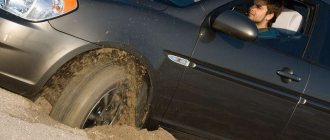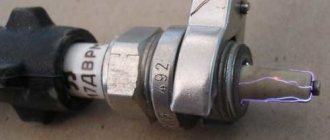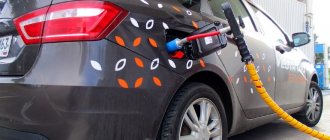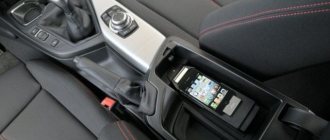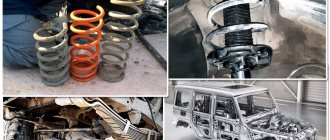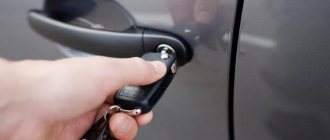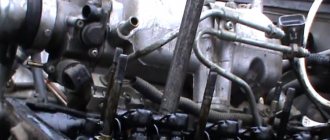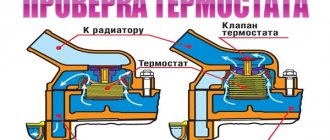To clean the windshield of a car in winter, when the temperature outside often drops below zero, you cannot pour ordinary water into the windshield washer reservoir - it will simply freeze.
In the cold season, car owners traditionally change the water to anti-freeze.
However, some drivers use anti-freeze all year round, and therefore do not worry about sudden changes in weather.
It's easier to buy antifreeze. However, if this is not possible (for example, you went to a remote village where there have never been any auto shops), then there is only one way out - to prepare antifreeze liquid with your own hands.
Is it difficult? Probably not. The main thing is to know what ingredients to use for this, and in what proportions
they need to be mixed so that you get exactly the anti-freeze for glass, and not some strange mixture with a “vigorous” smell.
If you bought anti-freeze at a car dealership and it has a strong, unpleasant odor, it is most likely made from isopropyl alcohol.
As a rule, such mixtures are the cheapest, which is why many drivers fall for them.
It’s better to fork out a little and buy a winter washer based on ethyl alcohol. Today this is the best option.
Well, if you don’t want to support washer manufacturers, then we’ll tell you how to make an anti-freeze
at home.
We would like to warn you right away: it is not enough to simply mix the first ingredients that come to hand “by eye”.
In order for the anti-freeze to perform its main functions (clean glass and not freeze at temperatures below 0 degrees), it is important not only to use the correct components, but also to mix them in strictly defined proportions
.
What types of antifreezes are there?
The assortment of retail outlets includes two types of liquids that can withstand frost.
- No alcohol. Produced on the basis of chemical compounds. It is distinguished by sufficient resistance to freezing and the complete absence of a characteristic odor.
- Alcohol. The more common version is popular due to its moderate cost and good efficiency.
Usually, do-it-yourself anti-freeze is made according to a similar formula as the factory one. But in this case, the buyer independently determines the quality and quantitative ratio of the components of the formula.
Method number 5 - add ammonia
Sometimes motorists prefer to make a solution by adding ammonia to it. Here you should adhere to a ratio of 1:3 (one part ammonia to 3 parts water). When preparing the mixture, try to prevent the formation of foam. The main disadvantage of this solution is that it is strictly not recommended to use it if the temperature drops significantly; it will quickly freeze. To prevent this from happening, you can try adding about one hundred grams of vinegar to the composition.
Basic rules of procedure
It is important to know that mixing chemical compositions yourself is a responsible process that requires protective equipment and careful adherence to proportions.
Before the procedure, it is necessary to carefully study the components for the presence of toxic or other negative effects on the human body. This is required because part or vapor of the finished product must get inside the car.
Also, only purified water (distillate) is used in the experiments - this will eliminate unexpected reactions of the base with impurities.
What's in commercial windshield wiper fluid?
First, let’s look at what the classic “anti-freeze” bags that are sold in stores are made from.
They are based on alcohol, which can be one of the following types:
- Methyl . According to the legislation of the Russian Federation, the use of such alcohol in the process of manufacturing “chemicals” (for household use and cars) is prohibited. Despite this, many manufacturers commit violations and add cheaper alcohol to products (naturally, keeping silent about this on the packaging). The only advantage of methyl alcohol is its low cost. But its vapors are dangerous to humans, primarily when inhaled.
- Isopropyl . This type of alcohol has gained popularity due to its affordable price. Unlike “methyl”, its vapors do not harm the body, but at high concentrations the car’s paintwork may be damaged. It is not difficult to recognize antifreeze made using isopropyl alcohol - it has a strong and unpleasant “aroma” that is similar to acetone.
- Ethyl . The use of such alcohol in the manufacture of anti-freeze is the best option. Its advantages are the absence of a pungent odor and harm to health. The main disadvantage is the high price, which is why ethyl alcohol is rarely used in the manufacture of anti-freeze.
Thus, alcohol is the main component of antifreeze windshield washer fluid.
In addition to this, the composition includes:
- Purified water. With its help, it is possible to reduce the price of products and adjust the freezing temperature of the product.
- Detergent compositions that provide better surface cleaning from contaminants.
- Dyspnea - special means that mask the unpleasant odor.
- Dyes. They do not carry any functional load - they simply ensure the attractiveness of the composition and distinguish it from competitors.
How to make a winter washer at home: basic recipes
From the entire range of possible combinations, the most popular and effective mixtures can be identified.
Based on window cleaner
To prepare the mixture, you will need to buy a high-quality alcohol-based product. It is recommended to read in the instructions or on the container insert how much ethyl or its analogue is contained in the composition.
The standard proportion is a 1:2 combination, where one portion is detergent, and two parts are supplemented with water.
The result is a do-it-yourself anti-freeze solution for cars of any design and layout. The advantages include quick preparation and availability of components. If the tank is empty on the road, the supply of liquid can be quickly replenished at any household chemical store.
Buyers consider the low crystallization temperature to be a disadvantage. Depending on the content of the active component, the composition hardens already at -10/15 degrees Celsius.
Anti-freeze for cars based on dishwashing detergent
Do-it-yourself anti-freeze without alcohol can be created from common household liquid. The most important parameter here is the quality of the dish soap itself. The liquid contains frost-resistant components and copes well with misuse. Buyers especially praise the varieties produced in concentrate form.
The preparation itself is also not difficult. To make it, just pour 1-2 tablespoons of the product into 3 liters of water. Then everything is thoroughly mixed and poured into the washer reservoir.
Among the positive qualities of the method, it is cheap and accessible - the ingredients are present in every home. There is also good economy. A portion of the finished composition requires a minimum amount of active additive.
The disadvantages include questionable effectiveness in severe frosts. Some users insist that this formula cannot even withstand -15 ˚С.
Vinegar base for car anti-freeze
Do-it-yourself anti-freeze for cars can even be made from ordinary table vinegar. The product contains a little alcohol, but due to its low concentration, the finished liquid will freeze at -1/2 degrees. Thus, the formula is suitable only for the southern regions or the autumn-spring period.
To improve the properties, a gel-like dishwashing detergent is added to the product. The upgraded solution can work even at -10 ˚С.
The recipe is as follows.
- Take table vinegar and prepared water in equal proportions.
- Stir the base thoroughly.
- Add 1-1.5 tbsp to the product. dish cleaner.
- Stir the resulting mass again.
If done correctly, the product will not crystallize and will ensure streak-free application.
Among the disadvantages of the method, buyers highlight the strong smell of vinegar when processing glass during severe frosts.
Ammonia-based product
Such a do-it-yourself antifreeze for a car is usually prepared if you have access to the main drug. For the base, 1 part of the active substance and 3 parts of distilled water are used. You can improve efficiency by adding 1/10 table vinegar by weight of the finished product (100g/liter).
Separately, some car enthusiasts add fragrances that improve the smell in the car interior.
The disadvantages include the difficulty of finding the main component and questionable performance.
DIY anti-freeze made from alcohol
As a base, it is recommended to use only ethyl alcohol sold in pharmacies (medical grade for internal use). It is strictly forbidden to use technical analogues due to the toxic effects of vapors on the human body. Inapplicable types include methyl, isopropyl and technical methyl alcohols. If the evaporation of these liquids enters the body, this will entail irreversible consequences.
Anti-freeze from vodka has long been used in the CIS countries and Russia in particular, as the main substitute for factory formulas. The technology was especially widespread during the Soviet era, when auto chemicals were inaccessible to the common man.
The essence of the procedure is to dilute pure alcohol to a strength of 20-30 degrees. Crystallization will occur after overcoming the established threshold. Typically the mixture is composed at a ratio of 1:5. After dilution, you will need to mix everything thoroughly and add a tablespoon of dry washing powder and shake the finished substance until the solid particles are completely dissolved.
The advantages include the simplest formula and the availability of all its components. The only critical drawback is the smell. When using the mixture, some of the vapors are drawn into the car's interior and smell strongly of fumes. In such a case, driving with the windows closed is simply impossible, and traffic police officers will simply be required to conduct an examination of the driver.
Hodgepodge
You can also get a good anti-freeze product yourself by mixing several components. Motorists have repeatedly proven that when mixing popular components like:
- distilled water;
- shampoo;
- glass cleaner;
- concentrated dish gel.
It turns out that you can make a good slurry that can withstand severe frosts and at the same time does not harden.
Why does windshield washer fluid not freeze in winter?
At subzero temperatures, only ordinary water freezes. All other substances have a phase transition point from liquid to ice above or below zero on the Celsius scale.
If you take a liquid that freezes well below zero, then you can even dilute it with water, the resulting solution will still remain in a fluid state in not very severe frosts, and by adjusting the concentration you will be able to achieve the desired effect even in very severe frosts, when the actual operation of the car is approaching to the feat.
And no heating of the tank, pipelines or injectors is required.
Tests before use
Any homemade winter wash requires preliminary inspection and testing. If the proportions are not correct, or the quality of the components is poor, the formula can quickly freeze or give an unexpected result.
For testing, drivers use a balcony or freezer. The procedure itself looks like this.
- Pour the product into a bottle and leave it in a cool place.
- Wait 12-15 hours for the product to cool completely.
- Check for ice crystals in the mixture. If particles are found in an amount of less than 5% of the total mass, the product can be poured into the machine.
If you find that the product has completely frozen, it is better to use it to wash the windows in your apartment.
Next, you will need to pour a small amount of homemade washer into the tank of the car. The essence of the test is to check the performance of the “product” under field conditions. If the result is positive, the lines should pass freely and the pumps should produce the required pressure. Cleaning ability is also taken into account - the formation of residue or oil films on the glass is not recommended.
Precautionary measures
If you are preparing anti-freeze with your own hands, the proportions must be carefully observed. If mixed incorrectly, the performance of the product can be greatly reduced.
Caution must also be taken into account.
- All work is carried out in a well-ventilated area.
- You should make sure in advance that all components are safe.
- Do not forget to protect your hands, eyes and respiratory organs.
- When creating alcohol-containing formulas, it is strictly forbidden to use any type other than ethyl alcohol.
- Before actual use, test a small part of the product on the machine.
Method No. 1 - using a regular windshield wiper
Very good results can be obtained by mixing any household glass cleaner, which can be purchased in the household appliances department. These products are designed to clean any glass surfaces. It is important to check that these products contain alcohol; it is this that will prevent the liquid in the washer reservoir from freezing. In order to save money and to avoid excessive foaming of the composition, the glass cleaner should be mixed with ordinary or distilled water. It is recommended to mix in a ratio of 1 to 2, that is, take one part of the glass cleaning liquid and add two parts of water to it.
Method No. 7 - add methanol
Methanol is also a non-freezing alcohol, but it is an extremely harmful substance for humans. When deciding to prepare such a mixture, you need to be extremely careful and avoid getting it on the skin or in the respiratory tract. This toxic liquid should be mixed with water as follows: 900 ml. add no more than 100 ml of water. methanol.
Making your own windshield washer fluids can save you some money in the long run, but it requires some knowledge and care on the part of the car owner. Thus, only you can decide what is better: buy a ready-made solution or prepare it yourself.
